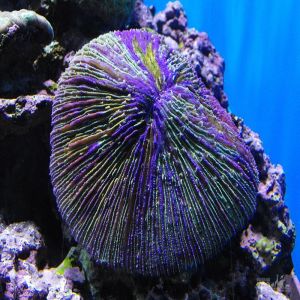 The Mushroom Coral is common and widespread and can occur in dense clusters on reef flats and slopes. The most important known threat for this species is extensive reduction of coral reef habitat due to a combination of threats. Threats of habitat loss, coral bleaching, and the collection of the corals for aquarium and curio trade have made it listed as Near Threatened. Because of ocean acidification and reef degradation it will be important to keep tabs on its survival. Coral disease is a serious threat to coral reefs worldwide and a major cause of reef deterioration. The main predator for the mushroom coral is the crown of thorns starfish. The mushroom coral is found on back reef, flat reef, reaf slopes, and lagoons. This is a solitary, freeliving coral found at depths of 1-20 meters.
The Mushroom Coral is common and widespread and can occur in dense clusters on reef flats and slopes. The most important known threat for this species is extensive reduction of coral reef habitat due to a combination of threats. Threats of habitat loss, coral bleaching, and the collection of the corals for aquarium and curio trade have made it listed as Near Threatened. Because of ocean acidification and reef degradation it will be important to keep tabs on its survival. Coral disease is a serious threat to coral reefs worldwide and a major cause of reef deterioration. The main predator for the mushroom coral is the crown of thorns starfish. The mushroom coral is found on back reef, flat reef, reaf slopes, and lagoons. This is a solitary, freeliving coral found at depths of 1-20 meters.
Location: Animals Formerly at Zoo
Share:
Range
Indo-west Pacific in the Red Sea and Gulf of Aden, Indian Ocean, and around Australia, South-east Asia, southern Japan and the East China Sea.
Habitat
This species is found on back reef, flat reef, reef slopes and lagoons. It can occur in very dense clusters on reef flats and multi-species fungiid assemblages on slopes.
Conservation Status
Near Threatened
Primary Threats
fishing, commercial/residential development, invasive species and diseases
Gestation
The growth of the mushroom coral depends on the reef, nutrients, and predators. Being asexual, there is not an actual gestation time.
Litter
It is thought that the mushroom coral lives more than ten years. The maturity of most reef building corals typically is three to eight years and the average generation length is ten years.
Behavior
It is always attached as a juvenile and free living as an adult, and as a result it is mobile. It is a good competitor and can live on a variety of substrata.
Reproduction
It is a good asexual reproducer and often occurs in clusters as a result. The species is one of the first colonizers to settle in blasted areas and thrives in disturbed environments.
Wild Diet
Nutrients found in the water column around the coral.
Zoo Diet

